 W
WThe Andy Gibson was a steamboat that serviced the headwaters of the Mississippi River in the U.S. state of Minnesota from 1884 to 1894. After her retirement, the ship was left in a drydock outside her home port of Aitkin, Minnesota, and gradually dismantled for parts. The hull and drydock eventually sank out of sight. It is thus unique among U.S. shipwrecks for still resting on a drydock cradle. The Andy Gibson shipwreck was listed on the National Register of Historic Places in 2012 for having state-level significance in the themes of commerce, engineering, entertainment/recreation, maritime history, non-aboriginal historic archaeology, and transportation. It was nominated for comprising the rare and well-preserved remains of a Mississippi River steamboat.
 W
WUSS Black Hawk (1848) was a large steamer purchased by the Union Navy during the American Civil War.
 W
WThe City-class ironclad USS Cincinnati was a stern-wheel casemate gunboat in the United States Navy during the American Civil War. She was named for Cincinnati, Ohio, and was the first ship to bear that name in the United States Navy.
 W
WThe Pook Turtles, or City-class gunboats to use their semi-official name, were war vessels intended for service on the Mississippi River during the American Civil War. They were also sometimes referred to as "Eads gunboats." The labels are applied to seven vessels of uniform design built from the keel up in Carondelet, Missouri shipyards owned by James Buchanan Eads. Eads was a wealthy St. Louis industrialist who risked his fortune in support of the Union.
 W
WUSS Conestoga was originally a civilian side-wheel towboat built at Brownsville, Pennsylvania, in 1859. She was acquired by the U.S. Army in June 1861 and converted to a 572-ton "timberclad" river gunboat for use by the Western Gunboat Flotilla, with officers provided by the navy.
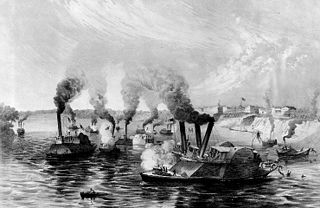 W
WCSS General Beauregard was a cottonclad sidewheel ram of the Confederate Navy during the American Civil War.
 W
WThe MV George Prince ferry disaster was a nautical disaster that occurred in the Mississippi River in St. Charles Parish, Louisiana, United States, on the morning of October 20, 1976. The Luling–Destrehan Ferry George Prince was struck by the Norwegian tanker SS Frosta which was traveling upriver. The collision occurred at mile post 120.8 above Head of Passes, less than three-quarters of a mile from the construction site of the Luling Bridge which would replace the ferry seven years later. The ferry was crossing from Destrehan, Louisiana on the East Bank to Luling, Louisiana on the West Bank. Ninety-six passengers and crew were aboard the ferry when it was struck, and seventy-eight perished. This accident is the deadliest ferry disaster in United States history. It is also the deadliest peacetime nautical disaster involving a non-submersible vessel in U.S. waters since the explosion of the SS Grandcamp in 1947, which killed 581 people. In addition, it is the deadliest accident involving a single vessel in U.S waters since a fire on board the SS Morro Castle in 1934, which killed 137 people.
 W
WLSNS Governor Moore was a schooner-rigged steamer in the Confederate States Navy.
 W
WUSS Inaugural (AM-242) was an Admirable-class fleet minesweeper. The Admirable class was the largest and one of the most successful classes of U.S. minesweepers ordered during World War II. Inaugural was launched on 1 October 1944 and commissioned less than three months later. After seeing combat in the Pacific Theater, she was decommissioned in 1946 and spent two decades in mothballs.
 W
WThe Steamboat Iowa was revered as one of the largest and fastest boats on the Mississippi in the mid 19th century; it is incorporated into the official Seal of Iowa. Built in 1838, the Iowa was the first vessel named for the newly formed Territory of Iowa. It weighed 112 tons, could pull 10 keelboats, and it set the speed record from Galena, Illinois to St. Louis in 1843, making the trip in 44 hours, a record that held until 1849. The Iowa was hired by Mormon supporters of Joseph Smith, Jr. as part of a plan to rescue him from jail in June 1843; the excursion was cancelled after Smith was murdered in jail. The Iowa sank after a collision with the steamboat Declaration on Oct. 1, 1847 while traveling from New Orleans to St. Louis. This liability for this collision was ultimately decided by the U.S. Supreme Court case John Walsh v. Patrick Rogers. However, the Iowa was apparently rebuilt, or a new steamboat was later rechristened Iowa, since similar side-wheeler appeared twice in Barber and Howe's 1865 Loyal West in the Time of Rebellion, and there is reference to the Iowa being used as a troop transport during the Civil War.
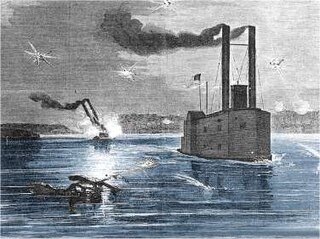 W
WUSS Lancaster was a sidewheel civilian steamer tow boat built in 1855 at Cincinnati. It was originally named Lancaster Number 3 then Kosciusko. In March through May 1862, she was purchased and converted to a ram by Colonel Charles Ellet Jr. to serve during the American Civil War as part of the United States Ram Fleet and the Mississippi Marine Brigade.
 W
WLaurent Millaudon was a wooden side-wheel river steamboat launched at Cincinnati, Ohio, in 1856 operating in the New Orleans, Louisiana, area, and captained by W. S. Whann. At the beginning of the American Civil War she was taken into service by the Confederate Navy as CSS General Sterling Price. On 6 June 1862, she was sunk at the Battle of Memphis. She was raised and repaired by the Union army, and on 16 June 1862 was moved into Union service as USS General Price and served until the end of the war.
 W
WLittle Rebel was a cotton-clad ram that had been converted from a Mississippi River steamer to serve as the flagship of the Confederate River Defense Fleet in the American Civil War. Sent from New Orleans to defend against the Federal descent of the Mississippi, she was among the force that engaged vessels of the Union Army's Western Gunboat Flotilla at the Battle of Plum Point Bend on May 10, 1862. On June 6, she again was involved in an action with the Federal gunboats, this time at the Battle of Memphis. In the battle, a shot from a Federal gun pierced her boiler, disabling her, and she was then pushed aground by the Federal ram USS Monarch and captured.
 W
WM.E. Norman was a sternwheel steamboat operated by the U.S. Army Corps of Engineers. On May 8, 1925, M.E. Norman sank after capsizing in the Mississippi River. Tom Lee, an African American riverworker, saved the lives of 32 passengers.
 W
WCSS Manassas, formerly the steam icebreaker Enoch Train, was built in 1855 by James O. Curtis as a twin-screw towboat at Medford, Massachusetts. A New Orleans commission merchant, Captain John A. Stevenson, acquired her for use as a privateer after she was captured by another privateer CSS Ivy. Her fitting out as Manassas was completed at Algiers, Louisiana; her conversion to a ram of a radically modern design made her the first ironclad ship built for the Confederacy.
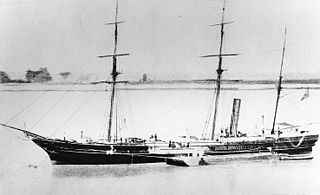 W
WCSS McRae was a Confederate gunboat that saw service during the American Civil War. Displacing around 680 tons, she was armed with one 9-inch (229 mm) smoothbore and six 32-pounder (15 kg) smoothbore cannon.
 W
WThe first USS Mingo, a stern-wheel steamer built at California, Pennsylvania, in 1859 and used to tow coal barges, was purchased at Pittsburgh by Colonel Charles Ellet Jr. in April 1862 for usage in the U.S. Ram Fleet during the American Civil War.
 W
WCSS Mississippi was a projected ironclad warship of the Confederate States Navy, intended to be used on the Mississippi River in the vicinity of New Orleans during the American Civil War. Her design was unusual, as she was built according to house-building techniques. Whether this would have proved to be feasible cannot be known, as she was not complete when New Orleans fell to the Union Fleet under Flag Officer David G. Farragut on 25 April 1862. Rather than let her fall into enemy hands, Captain Arthur Sinclair, CSN, ordered her to be hastily launched and burned. Despite the delays in construction that left her unfinished and untried, her mere existence, together with that of CSS Louisiana, raised thwarted hopes in the defenders of New Orleans, and unfounded fears in Union circles, that affected the strategy of both sides in the campaign on the lower Mississippi. Mississippi is significant to the Civil War therefore not so much as a warship as in the way her reputation influenced events, and as an example of the difficulties the South had in the contest with the industrial North.
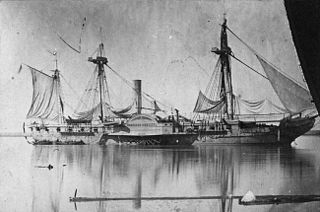 W
WUSS Mississippi, a paddle frigate, was the first ship of the United States Navy to bear that name. She was named for the Mississippi River. Her sister ship was Missouri. Her keel was laid down by the Philadelphia Navy Yard in 1839; built under the personal supervision of Commodore Matthew Perry. She was commissioned on 22 December 1841, with Captain W. D. Salter in command and launched several weeks later.
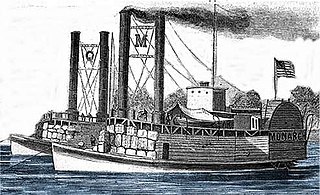 W
WUSS Monarch was a United States Army sidewheel ram that saw service in the American Civil War as part of the United States Ram Fleet and the Mississippi Marine Brigade. She operated on the Mississippi River and Yazoo River during 1862 and 1863.
 W
WUSS Mound City was a City-class ironclad gunboat built for service on the Mississippi River and its tributaries in the American Civil War. Originally commissioned as part of the Union Army's Western Gunboat Flotilla, she remained in that service until October 1862. Then the flotilla was transferred to the Navy and she became part of the Mississippi River Squadron, where she remained until the end of the war.
 W
WPioneer was the first of three submarines privately developed and paid for by Horace Lawson Hunley, James McClintock, and Baxter Watson.
 W
WUSS Rattler (1862) was a steamer acquired by the Union Navy during the American Civil War.
 W
WUSS Sciota was a Unadilla-class gunboat built on behalf of the United States Navy for service during the Civil War. She was outfitted as a gunboat, with both a 20-pounder rifle for horizontal firing, and two howitzers for shore bombardment, and assigned to the Union blockade of the waterways of the Confederate States of America.
 W
WThe Sea Wing disaster occurred on July 13, 1890 when a strong squall line overturned the excursion vessel Sea Wing on Lake Pepin near Lake City, Minnesota. Approximately 215 people were aboard the vessel when it overturned and as a result of the accident 98 passengers drowned. An excursion barge that was being towed by the Sea Wing was either cut loose or broke loose and survived the disaster with its passengers unharmed. It is one of the worst maritime disasters that has occurred on the upper Mississippi River.
 W
WStar of the West was an American civilian steamship that was launched in 1852 and scuttled by Confederate forces in 1863. In January 1861, the ship was hired by the government of the United States to transport military supplies and reinforcements to the U.S. military garrison of Fort Sumter. A battery on Morris Island, South Carolina manned by cadets from the South Carolina Military Academy fired upon the ship, effectively the first shots fired in the American Civil War.
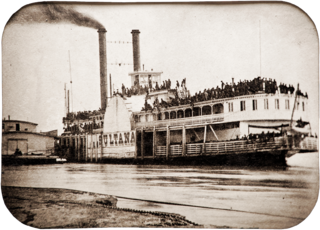 W
WSultana was a Mississippi River side-wheel steamboat, which exploded on April 27, 1865, in the worst maritime disaster in United States history.
 W
WUSS Varuna (1861) was a heavy steam-powered ship acquired by the Union Navy during the early days of the American Civil War. She was outfitted with powerful 8-inch guns and assigned, as a gunboat, to the Union blockade of the waterways of the Confederate States of America.
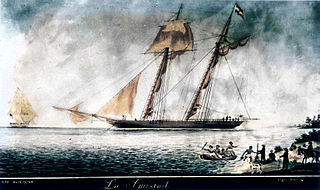 W
WWashington was a revenue cutter that served in the United States Revenue Cutter Service and in the United States Navy. She discovered, boarded and captured La Amistad after the slaves onboard had seized control of that schooner in an 1839 mutiny.
 W
WCSS Webb, a 655-ton side-wheel steam ram, was originally built in New York City in 1856 as the civilian steamship William H. Webb. She received a Confederate privateer's commission at New Orleans in May 1861, but was instead employed as a transport until January 1862. Converted to a "cotton clad" ram by the Confederate Army, thereafter served on the Mississippi and Red Rivers. On February 24, 1863, under the command of Captain Charles Pierce, she participated in the sinking of the Federal ironclad USS Indianola. Webb was transferred to the Confederate Navy in early 1865.
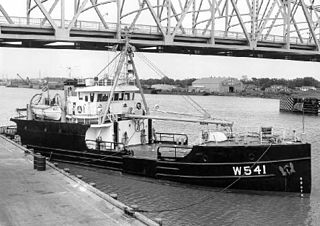 W
WThe USCGC White Alder (WLM/WAGL-541) was the former Navy lighter, YF-417. The United States Coast Guard acquired a total of eight of these former Navy YF-257-class lighters between 1947-1948 for conversion to coastal buoy tenders. They were needed to complement the larger seagoing buoy tenders in servicing short-range-aids-to-navigation, typically those placed in coastal waters and harbors.